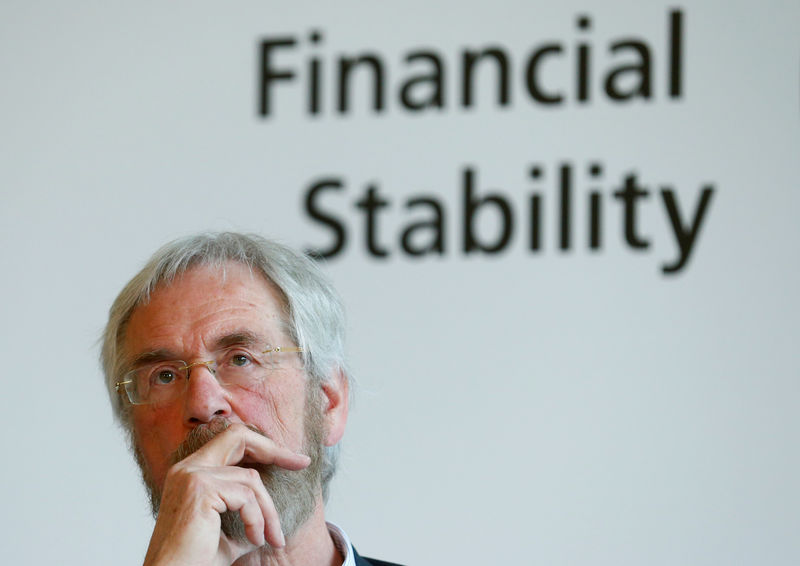 © Reuters. ECB executive board member Praet attends the ECB and Its Watchers conference in Frankfurt
© Reuters. ECB executive board member Praet attends the ECB and Its Watchers conference in FrankfurtBy Balazs Koranyi and Frank Siebelt
FRANKFURT (Reuters) – Europe may be regaining some of its long-lost growth potential, European Central Bank chief economist Peter Praet said, a boon for the bloc’s five-year expansion but a potential drag on already weak inflation.
The 19-member currency bloc may have more unexploited capacity, particularly in the labor market, which could mean that inflation might take longer to rise back to the ECB’s target of almost 2 percent, Praet, 69, told Reuters in an interview.
Having revived growth with years of stimulus, the ECB is now slowly clawing back support and investors are searching for clues about its next move after a token change in its policy language earlier this month.
Markets expect the ECB to end its 2.55 trillion euro bond purchase scheme this year and Praet’s comments suggest that policymakers will continue to take a gradualist approach, moving by small increments, fearing that abrupt moves could upset markets and unravel its efforts to keep borrowing conditions loose.
“It is clear that if you believe that the degree of slack is higher, then the process of convergence to below, but close to, 2 percent over the medium term would be drawn out,” the Belgian economist told Reuters in an interview. “Other things being equal, it would (mean a) shallower (inflation path)”.
“Mario Draghi was opening the conversation on the possibility that there may be more slack in the economy,” Praet said, referring to recent comments from the ECB President. “That still needs to be confirmed but we already have strong evidence of a strong labor supply reaction.”
More women, elderly workers and qualified labor from Central Europe coming into the market could be among the explanations for this unexpected labor supply, Praet added.
Inflation has undershot the ECB’s target for five years and will continue to miss it at least through the end of the decade, a risk to the ECB’s credibility as price stability is the bank’s singular objective.
While Praet said the debate was open about this slack, it would explain why growth and employment continue to surprise on the upside and inflation on the downside, seemingly contradicting a long-proven interaction between jobs and price growth.
Launched three years ago, the ECB’s bond purchase scheme is set to run until the end of September at 30 billion euros per month, already well below peak purchases at 80 billion euros.
‘WELL PAST’
Even if slack is bigger, the ECB is seeing an improvement in the path of inflation so the bank will eventually need to provide more much more clarity on its interest rate path, Praet argued.
The ECB’s guidance now stipulates that rates will stay at their current level until ‘well past’ the end of asset buys, a clause that will lose its potency as that point approaches.
“Markets quantify the ‘well past’ interval as ‘up to next spring’,” Praet said. “Once you stop net asset purchases the signaling aspect of the asset purchase program disappears and you therefore have to be much more precise about the future path of the short term rates.”
“As we move forward in time, as is natural, the relative importance of the three policy tools will change, and the main tool for shaping the policy stance will become the path of our key interest rates and the forward guidance about their likely evolution,” Praet said.
“As in the past, we will ensure that monetary policy controls the short end of the yield curve.”
The bank’s key deposit rate stands at -0.4 percent and markets see the first rate hike next spring with the rate moving to zero by the end of 2019.
“Market prices seem to be coherent with the narrowing of the gap between market-based inflation expectations and our objective. It’s a good sign. There is a convergence between market expectations and our intended end date, with the optionality,” he said.
The ECB earlier flagged a discussion about a new policy guidance and Praet argued that openly discussing life after bond buys is already a signal about such an exercise.
“The fact that the two of us are talking about this now is already very telling,” Praet said. “I would not revise the guidance too early, because that could send wrong signals about the end of our net asset purchases, which in any case are intended to run until the Governing Council sees a sustained adjustment in the path of inflation.”
But he said the ECB has time to take its decision on the guidance and the future of bond buys so it can still examine incoming data.
“We will proceed at a gradual pace, or a measured pace,” he said.
Weighing in on the topic of whether the ECB should end the bond buys in a single step or wind it down over several months, Praet said markets expect no cliff edge from the bank.
“Markets expect us to avoid cliff effects,” he said. “So people can judge what is coherent with a notion of prudence and could conclude that we will gradually bring net asset purchases to an end once the Governing Council sees a sustained adjustment path. I think it is well understood by the market.”
Source: Investing.com



























